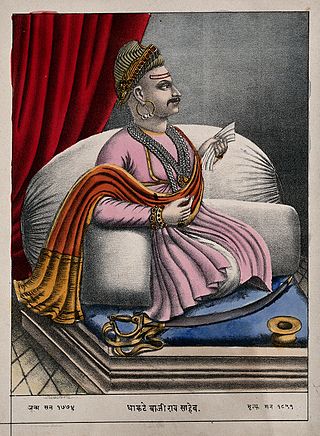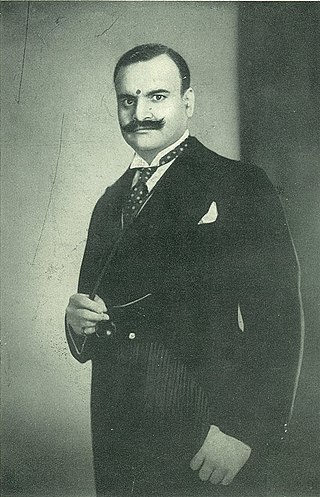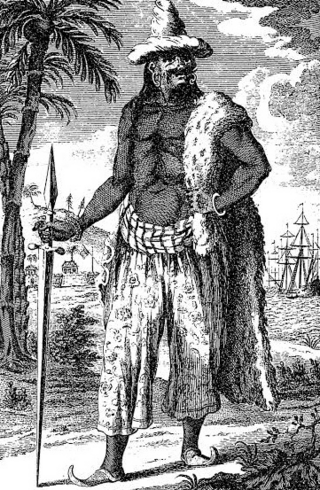
The Maratha Confederacy, also referred to as the Maratha Empire, was an early modern polity in the Indian subcontinent. It comprised the realms of the Peshwa and four major independent Maratha states often subordinate to the former. It was established in 1674 with the coronation of Shivaji as the Maratha Chhatrapati and recognised by Emperor Bahadur Shah I as a tributary state in 1707 following a prolonged rebellion. Following this, the Marathas continued to recognise the Mughal emperor as their nominal suzerain, similar to other contemporary Indian entities, though in practice, imperial politics at Delhi were largely influenced by the Marathas between 1737 and 1803.

The Peshwa was the second highest office in the Maratha Confederacy, next in rank and prestige only to that of the Chhatrapati. Initially serving as the appointed prime minister in the Maratha Kingdom, the office became hereditary after the death of Shahu in 1749. During the reign of Shahu, the office of Peshwa grew in power and the Peshwas came to be the de facto rulers of the Maratha Confederacy. However following the defeat of the Marathas in 1761, the office of the Peshwa became titular as well and from that point onwards served as the ceremonial head of the Confederacy underneath the Chhatrapati.

The Battle of Argaon took place on 29 November 1803, between the British under the command of Major-General Arthur Wellesley and the forces of the Bhonsles of Berar and the Scindias of Gwalior.

House of Scindia or earlier known as the Sendrak is a Hindu Maratha Royal House that ruled the erstwhile Gwalior State in central India. It had the Patil-ship of Kanherkhed in the district of Satara and was founded by Ranoji Scindia, who was sardar of maratha empire and real maratha warrior clan appointed by chattrapati shahuji maharaj-1's servant family from kokan worked as prime minister also known as Peshwa Bajirao I. Ranoji and his descendants, along with their rivals the Holkars, played a leading role during the Maratha ascendancy in northern India in the 18th-century. The Gwalior State became a princely state during the British Raj in the 19th and the 20th-centuries. After India's independence in 1947 and the abolition of princely states, several members of the Scindia (Shinde) family went on to enter Indian politics.

Kanhoji Angre, also known as Conajee Angria or Sarkhel Angré was a Maratha Navy officer. Kanhoji became known for attacking and capturing European East Indiamen and collecting jakat, seen by Europeans traders and colonists as ransoming of their crews. British, Dutch and Portuguese ships often fell victims to these raids.Despite attempts by the Portuguese and British to put an end to his privateering activities, Angre continued to capture and collect jakat from European merchant ships until his death in 1729. Kanhoji's naval prowess in capturing dozens of European trading ships and avoiding capture has led to many historians to appraise Kanhoji as the most skilled Indian navy chief in the maritime history of India.

Shahu I was the fifth Chhatrapati of the Maratha Confederacy founded by his grandfather, Shivaji I. He was born into the Bhonsle family, and was the son of Sambhaji I and Yesubai. At a young age, he was taken into custody at the Siege of Raigad by Mughal emperor Aurangzeb, and held captive. He was released from captivity after the death of Aurangzeb in the hope of engineering an internecine struggle among the Maratha factions of Tarabai and Shahu. Shahu emerged victorious in the bloody Battle of Khed and was crowned as Chhatrapati.

Baji Rao II was the 13th and the last Peshwa of the Maratha Confederacy. He governed from 1795 to 1818. He was installed as a puppet ruler by the Maratha nobles, whose growing power prompted him to flee his capital Poona and sign the Treaty of Bassein (1802) with the British. This resulted in the Second Anglo-Maratha War (1803–1805), in which the British emerged victorious and re-installed him as the titular Peshwa. In 1817, Baji Rao II joined the Third Anglo-Maratha War against the British, after they favoured the Gaekwad nobles in a revenue-sharing dispute. After suffering several battle defeats, the Peshwa surrendered to the British, and agreed to retire in return for an estate at Bithoor and an annual pension.

Jayajirao Scindia GCB, GCSI, CIE of the Scindia dynasty of Maratha Empire was the ruling Maharaja of Gwalior under the British rule from 1843 to 1886.

The Gwalior State was a state within the Maratha Confederacy located in Central India. It was ruled by the House of Scindia, a Hindu Maratha dynasty. Following the dissolution of the Confederacy, it became part of the Central India Agency of the Indian Empire under British protection.

The Jai Vilas Palace, is a nineteenth century palace in Gwalior, India. It was built in 1874 by Jayajirao Scindia, the Maharaja of Gwalior in the British Raj. While the major part of the palace is now the "Jiwajirao Scindia Museum" which opened to the public in 1964, a part of it is still the residence of some of his descendants.

The Kolhapur State was a Maratha princely state of India, under the Deccan Division of the Bombay Presidency, and later the Deccan States Agency. It was considered the most important of the Maratha principalities with the others being Baroda State, Gwalior State and Indore State. Its rulers, of the Bhonsle dynasty, were entitled to a 19-gun salute – thus Kolhapur was also known as a 19-gun state. The state flag was a swallow-tailed saffron pennant.

The following list includes a brief about the titles of nobility or orders of chivalry used by the Marathas of India and by the Marathis/Konkanis in general.

Jankoji Rao Scindia II, was Maharaja of Gwalior.

Baiza Bai was one of the wives of Daulat Rao Scindia, the ruler of Gwalior princely state in India, and served as regent after his death.

Sardar Chandroji Sambhaji Rao Angre was an Indian politician. He was a Member of Parliament, representing Madhya Bharat in the Rajya Sabha the upper house of India's Parliament as a member of the Hindu Mahasabha. He was a seventh-generation descendant of the famous Maratha admiral, Kanhoji Angre. He distinguished himself as the champion of Hinduism and was popularly called "Dharmvir". He was the Foreign and Political minister of Gwalior and was also vice-chairman of the Executive council of the Gwalior Kingdom, for the minority of raja Jivajirao Scindia. He succeeded his father Sambhajirao Angre as head of the Angre family in 1917.
Maharani Yesubai Bhonsale was the wife of Sambhaji, and referred to as Chatrapati Maharani of the Maratha Kingdom. She was also the mother of Shahu I. Sambhaji had shared with her his power as the emperor. When Sambhaji was away from the Maratha capital due to battles, all the political decisions were made by her. After Jijabai she is Kulmuktyar of Swarajya. After the execution of Sambhaji by Aurangzeb, she announced Rajaram as the next Chhatrapati of Swarajya. The Mughal Empire captured Raigad in November 1689 and arrested Maharani Yesubai and Shahu. The Mughals kept Maharani Yesubai captive to ensure that Shahu adhered to the terms of his release. She was released in 1719 when the Marathas became strong under Shahu and Peshwa Balaji Vishwanath.

Tulaji Angre, called Tulajee Angria by English historians was the grand admiral of the Maratha Navy and ruler of Colaba State in modern-day India. Similar to his famous father Kanhoji Angre, he too was an extremely skilled admiral and attacked several European trading ships. His achievements and naval prowess are considered to be greater than that of his father by some scholars and chroniclers. On various occasions he fought against the English, Dutch, Siddis And Portuguese maritime Powers. However, he alienated himself from the Maratha Peshwa, Balaji Baji Rao which led to his capture by the East India Company and Peshwa's forces at the Battle of Vijaydurg in 1756.
Colaba State, also known as Culaba State or Angria's Colaba was a Kingdom and later princely state in India. It was founded by the famous Maratha Navy admiral Kanhoji Angre in 1698. The ruling family of the state, the Angre, were skilled seafarers who controlled the western coast of India from the late 17th century- to the first half of the 18th century, until the Maratha Peshwa Balaji Baji Rao destroyed the major portion of their navy in the Battle of Vijaydurg.
Yesaji Angre was a military commander and the youngest son of Kanhoji Angre, the famed Maratha Navy admiral from his wife Gahinabai Bhonsle. He spent his naval career under the service of his elder half-brother Sambhaji Angre. The Gwalior branch of the Angre family was descended from him.
















